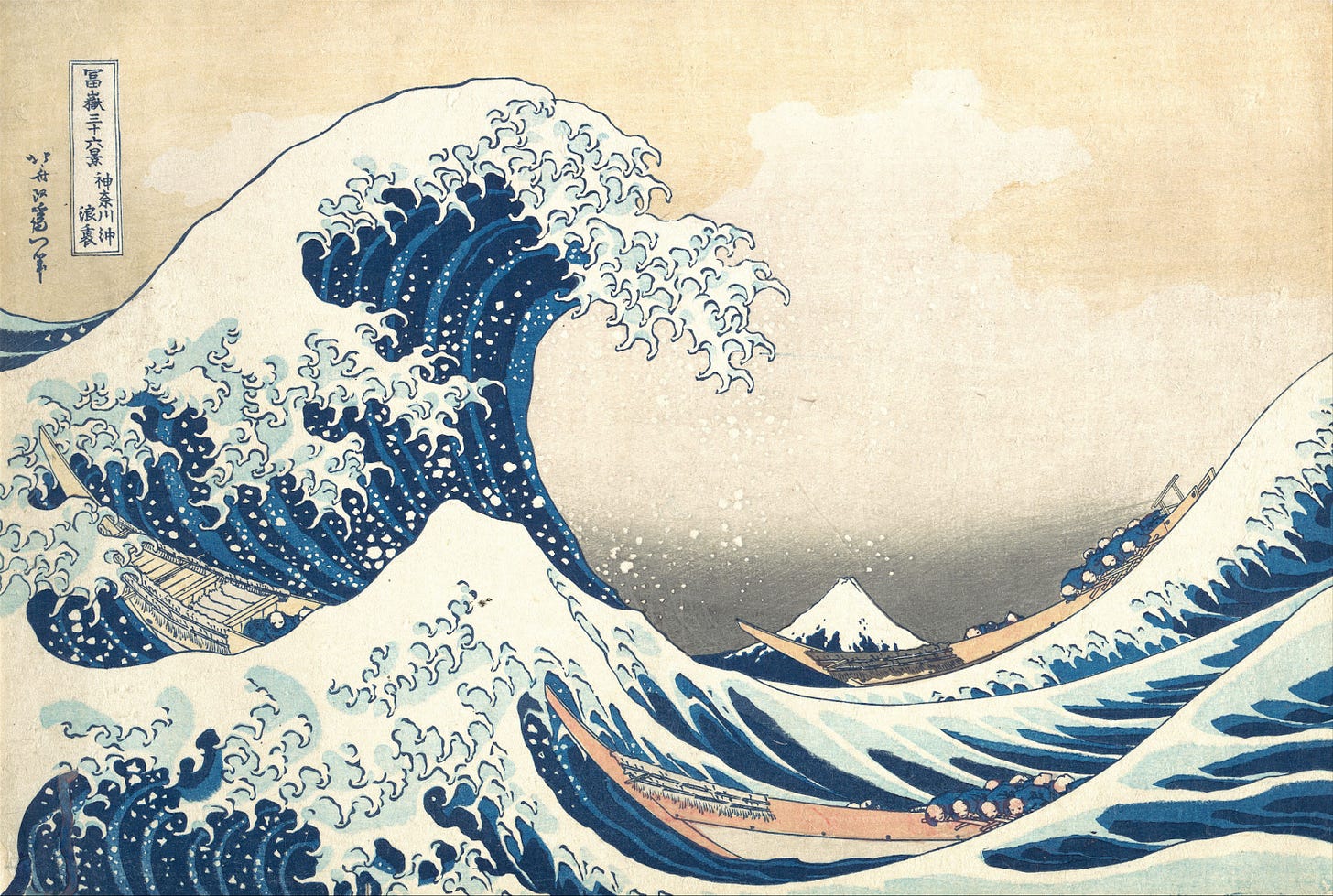Racing Against Time with Hokusai
Most people recognize The Great Wave off Kanagawa, but few know the fascinating story behind its creator, Hokusai.
Hokusai is one of the most unique artists I’ve researched, a person who reinvented himself 30 times and moved nearly 90 times.
His prints were sold widely at this year’s art fairs in New York City. Many of them reminded me of Hiroshige, another Japanese artist I covered in the second edition of Artobiography.
A Young Artist in Edo
Katsushika Hokusai was born in 1760 in Edo (now Tokyo) as the son of an artisan who made mirrors. At six years old, Hokusai was sent to work in a bookshop, where he was surrounded by woodblock prints that later inspired his imagination.
By 14, he was apprenticed to a woodblock printer and, at 18, joined the studio of Katsukawa Shunsho, a ukiyo-e artist known for kabuki actor portraits.
During his formative years, Hokusai became influenced by French and Dutch engravings. They were smuggled into Japan when contact with Western culture was forbidden. This exposure led him to experiment with Western techniques like perspective and shading, blending Eastern and Western influences into his work and gradually reshaping ukiyo-e into something entirely new.
A Perpetual Student of Art
Hokusai saw himself as a lifelong student of art. He believed mastery could only come with time, and as he grew older, he continuously reinvented his approach. One of the most striking things about Hokusai was his obsession with transformation. He didn’t just change his art style; he constantly reinvented himself as a person.
Hokusai is known to have used more than 30 pseudonyms throughout his career, a practice known as "gō" in Japanese art. From Shunro under his first master to Manji, his final name, each identity reflected his evolution.
Hokusai is also said to have moved more than 90 times during his life. This constant relocation was likely due to his restless spirit, obsession with change, search for inspiration, and financial difficulties.
Yet, behind the genius of Hokusai lay a life filled with challenges.
Obstacles Along the Way
Despite his talent, Hokusai faced poverty for most of his life. His eccentric dedication to art often led him to neglect practical matters, leaving him financially unstable and frequently alone.
His greatest obstacle, however, was time. Hokusai believed that true mastery came only with age, and his work became a race against the clock. As he aged, he felt a deeper urgency to improve his skills, often creating an internal struggle against time.
“...until the age of 70, nothing I drew was worthy of notice. At 73 years I was somewhat able to fathom the growth of plants and trees, and the structure of birds, animals, insects and fish. Thus when I reach 80 years, I hope to have made increasing progress, and at 90 to see further into the underlying principles of things, so that at 100 years I will have achieved a divine state in my art, and at 110, every dot and every stroke will be as though alive.” - Hokusai
Indeed, it was only in his later years that Hokusai would create his most iconic work.
A Late-Blooming Masterpiece
At the age of 70, Hokusai created the work that would make him an international icon: Thirty-Six Views of Mount Fuji. This series, which includes The Great Wave off Kanagawa, was a celebration of Japan’s most famous mountain and everyday life in Edo.

The series broke away from Japanese tradition by making landscapes the focal point, something rarely done before. By incorporating Western perspective techniques and vibrant Prussian blue pigments, he created a series that was both familiar and groundbreaking.
Thirty-Six Views of Mount Fuji became a sensation both in Japan and Europe.
Hokusai’s Lasting Legacy
Hokusai’s influence goes far beyond The Great Wave, even though it’s arguably the most recognizable piece of Japanese art in the world.
Hokusai produced over 30,000 works, including the Hokusai Manga, a series of sketchbooks that contained thousands of drawings that served as a visual encyclopedia of Japanese life.
He is credited with being the first to use the term "manga" to describe these random drawings. They are considered early examples of what is now a popular Japanese comic art form.
His relentless pursuit of perfection left a lasting impression on both Eastern and Western art. European impressionists like Vincent van Gogh and Claude Monet were inspired by Hokusai’s use of color and composition, and his influence can be seen in the development of modern graphic design and Art Nouveau.
Hokusai passed away on May 10, 1849, at the age of 88. On his deathbed, he famously said: “If only Heaven will give me just another ten years... Just another five more years, then I could become a real painter”.




